A gentle c section is a cesarean birth that is heavily focused on supporting the new family as a unit throughout the birth process, and less on traditional medical procedures and protocol. Here’s how to make it happen!
Cesarean Rates
Cesarean births are very common, especially in the United States. In my community the cesarean rates are around 40% for all women, and about 20% for first time moms. Where you live your cesarean rates may be higher or lower. One thing we can be sure of, however, is that a cesarean birth is a common method of birthing.
Because it’s so common, it makes sense that people have many ideas, thoughts, images, emotions, stories, etc., when it comes to cesarean births. Some of them may be positive or neutral, but many are negative.
Cesarean Birth
Because a cesarean is still a birth – a birth of a baby, mother, father… a family – I choose to use the term cesarean birth. Hanging out on a labor and delivery floor you’ll hear terms like section, or “she was a section” and frankly I just don’t like it.
Because I believe semantics matters, and it matters to use words that describe the whole picture, what really happened, I will typically say cesarean birth instead of all the other terms that are generally used. I believe using the term cesarean birth is the first step to having a gentle c section.
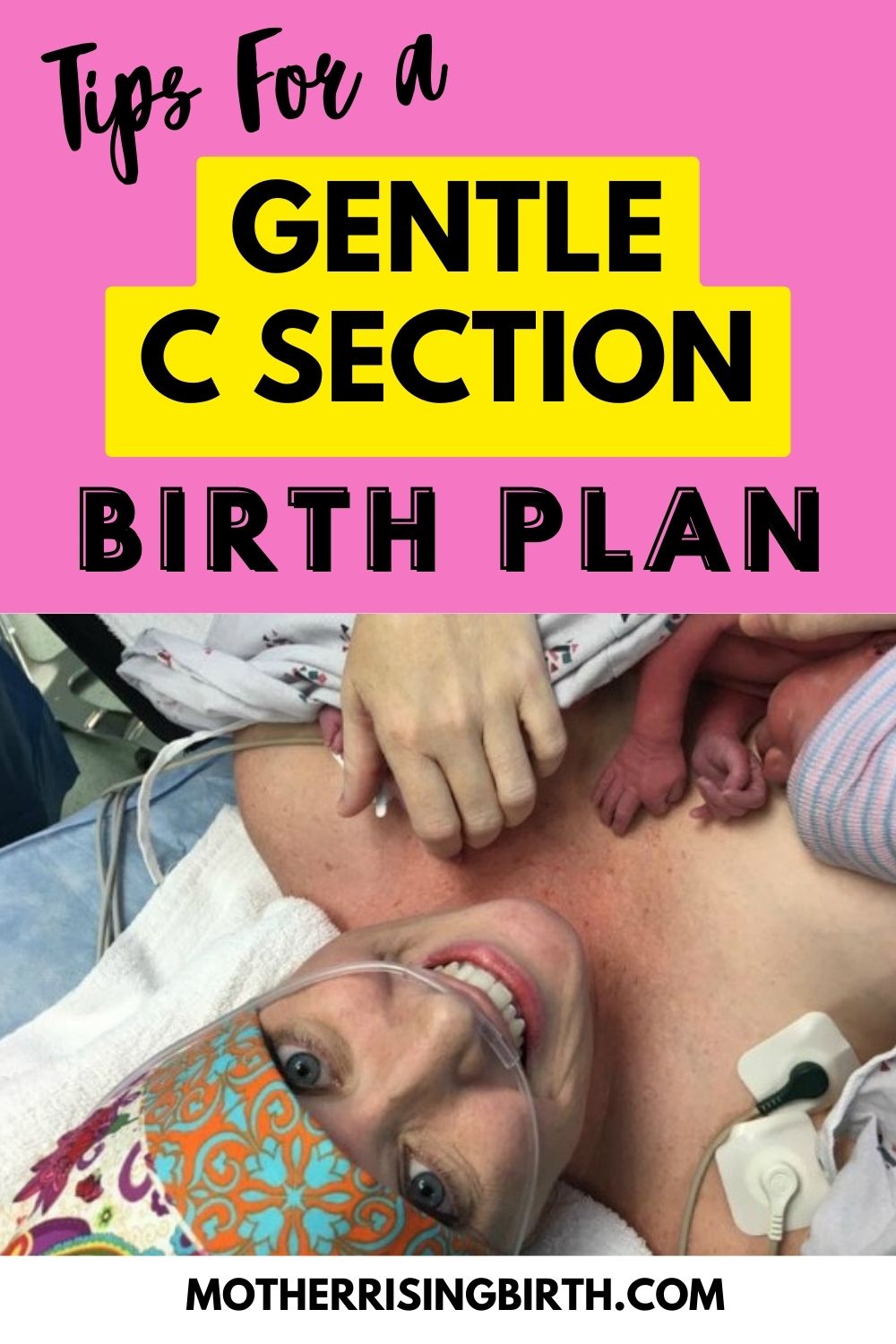
The Next Best Thing
Here at Mother Rising we have discussed many things that can help reduce the chances of having a cesarean.
- Plan for a natural childbirth.
- And if not, learn to cope well with normal labor pains before receiving an epidural.
- Use a birth plan as a means for exploring options and initiating communication with care providers during pregnancy.
- Hire a doula.
- Eat throughout labor.
- Stay hydrated during labor.
- Stay upright and change positions throughout labor.
- Ask questions and be a part of the decision making process with care providers.
- Or even fire your OB.
- Make the hormonal blueprint of labor work for you.
- Aim for an unmedicated birth in early and active labor and even throughout transition.
- Optimal fetal positioning.
- Taking advantage of natural birthing tips to reduce pain.
- Knowing the best time to arrive at the hospital.
This blog post, however, is not about reducing the risks of having a cesarean. This article is all about if, for whatever reason a cesarean became the next best thing, 1) this is what to expect but also 2) how to achieve a more gentle c section.
What Happens During a Cesarean Birth?
Mother’s Arms
One of the first things that happens at a cesarean birth is the mother is taken back to the operating room (OR) to be prepped for surgery and get a spinal, etc.
Mom lies on the operating table, on her back with her arms stretched out to each side. This position allows care providers access to blood pressure, IVs and keeps the mother’s arms out of the sterile field, etc. Typically, the arms are restrained to the table.
TIP: I have had doula clients that found the arm restraints to be awful and requested their arms to be left alone. Because she asked, the mother’s arms below were left alone. Talk to your care provider to discuss your options!
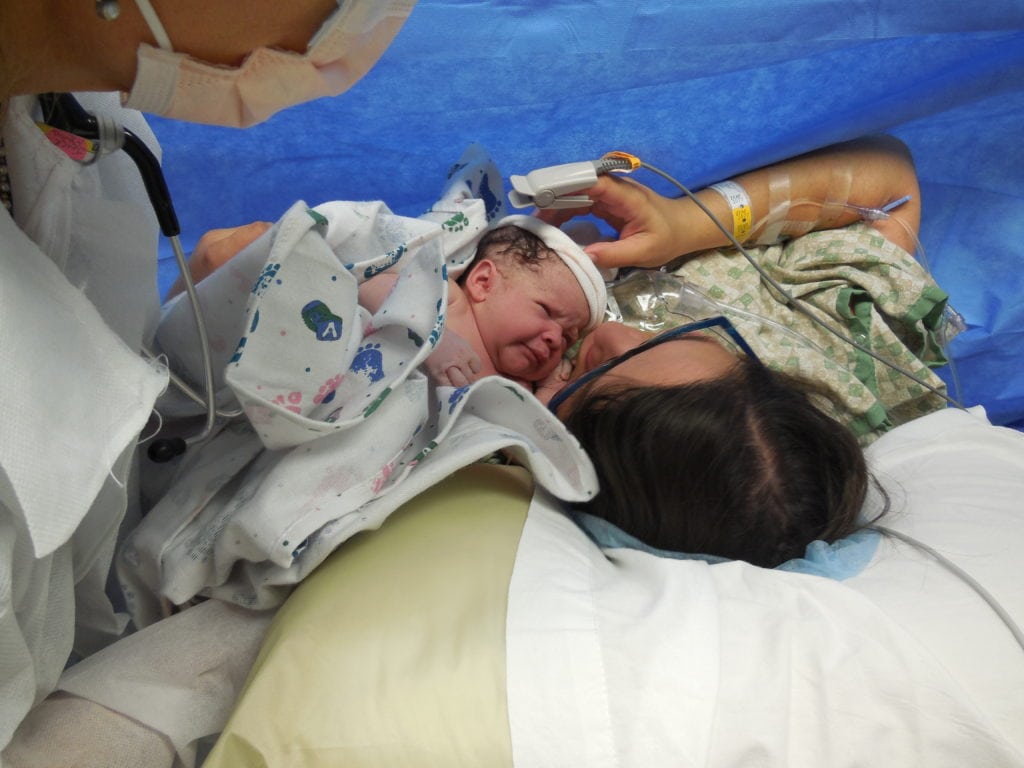
Sterile Field
Next, a sterile field is created by hanging a surgical drape that falls on the mother’s chest. It’s typically blue and made of the same material that everyone in the OR wears.
Some mothers like the blue drape – they don’t want to see. Some mothers want it lowered, or even use a clear piece of plastic instead, so that they can see the birth of their baby. Talk to your care provider to discuss your options!
TIP: If you really don’t want to see the surgery, don’t look at the lights above the operating room table. Many women have seen a reflection of their surgery while looking up!
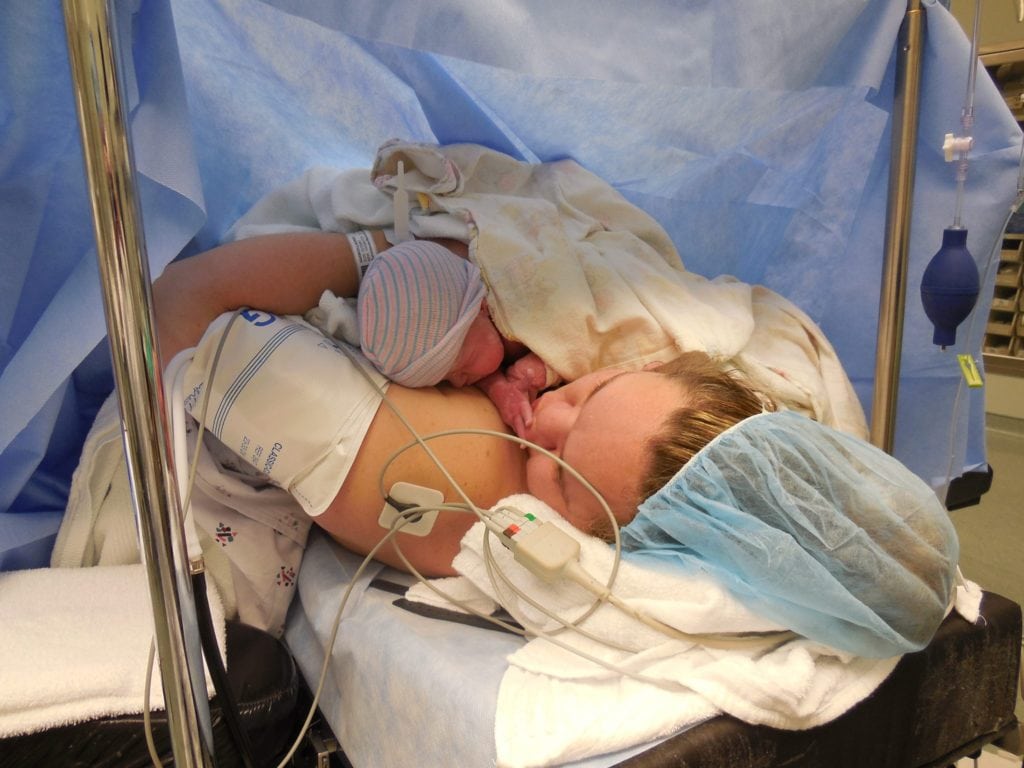
Mixed Feelings
At this point many women may have mixed feelings about what’s happening. Maybe she has been in labor for a very long time and she is feeling a bit of relief. FINALLY, she gets to meet her baby! Maybe she is feeling anxious about what’s happening. Maybe she is disappointed, or pissed off… or maybe she’s afraid. It’s pretty normal to be feeling lots of emotions before, during and after a cesarean birth.
TIP: Come postpartum, when you begin to process what happened, be kind to yourself and remember that a wide range of emotions is normal.
Separation
While mom is in the OR preparing for surgery, she leaves behind her birth partner (husband, partner, doula, friend, etc.). This is a difficult time to be separated from a support person, right before surgery begins. It’s important to be aware of and sensitive to this time of separation. If possible, minimize or eliminate this separation. Talk to your care provider to discuss your options.
While the mother is preparing for her cesarean birth, her birth partner will be getting dressed in their own set of scrubs. This is also a good time for them to collect personal belongings, if you have previously been in a labor and delivery room. Another task to consider is to call family and friends and update them of what is happening.
When dad joins mom in the OR, things may seem overwhelming and it might be hard for him to know where to look or what to do first. My suggestion is to head straight over to mom and take a quick moment to connect with her.
PARTNER TIP: Mom’s arms and head are above the sterile field so it is ok to touch, kiss, and hold her. In fact, if it is helpful, I highly recommend it! Pull down your face mask so she can see your face and take a moment to become grounded with one another.
PARTNER TIP: When dad enters the OR surgery will be happening. In fact, the birth may be imminent. Things will be moving quickly!
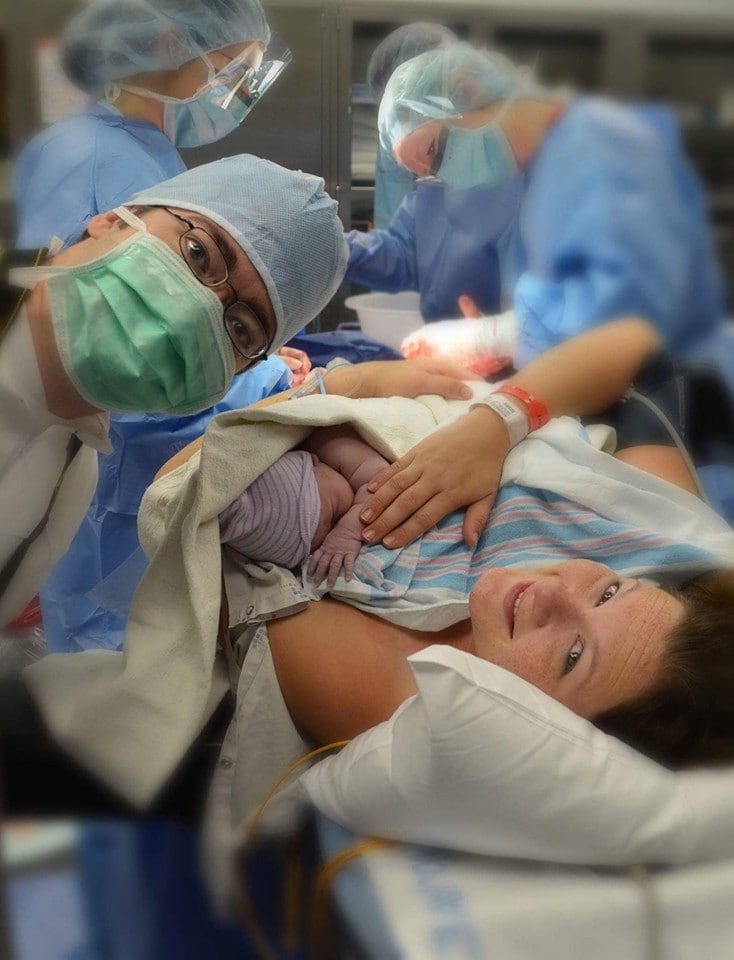
Doulas and Gentle C Sections
In my local hospital (TMH) an extra support person, or doula, is not allowed in the OR (exceptions have been made, however). In my other local hospital (CRMC) a doula, or extra support person, is allowed.
A doula is an amazing thing to have during a gentle c section. It ensures that a woman is never left without personalized support. A doula supports a mom before dad comes to the OR, while dad looks after the baby or even while dad is present as well.
Personally, I have never been allowed in the OR for a cesarean birth. I have been able to support my clients before and immediately after, but not during. How amazing would it be for a mother to have the option of continuous doula support even for a cesarean?!
A doula can be a calming presence in an otherwise unknown, stressful yet exciting moment (just like a vaginal birth!). Talk with your care provider to discuss your options.
About the OR
The OR will be brightly lit with a small crowd of people – the OBGYN, anesthesiologist, a baby team and nurses for assisting the doctors. There will be lots of medical equipment – shiny things that go ding. Many women close their eyes at this point and go within. For the women who don’t, she may find it helpful to lock eyes with her partner.
PARTNER TIP: It’s easy to get sucked into the surgery and the hustle and bustle of the OR. The best thing to do, however, is to pay attention to your woman and help her, whatever that may look like. Talk to her, pray with her, hold her hand, look into her eyes, or just sit quietly taking slow deep breaths.
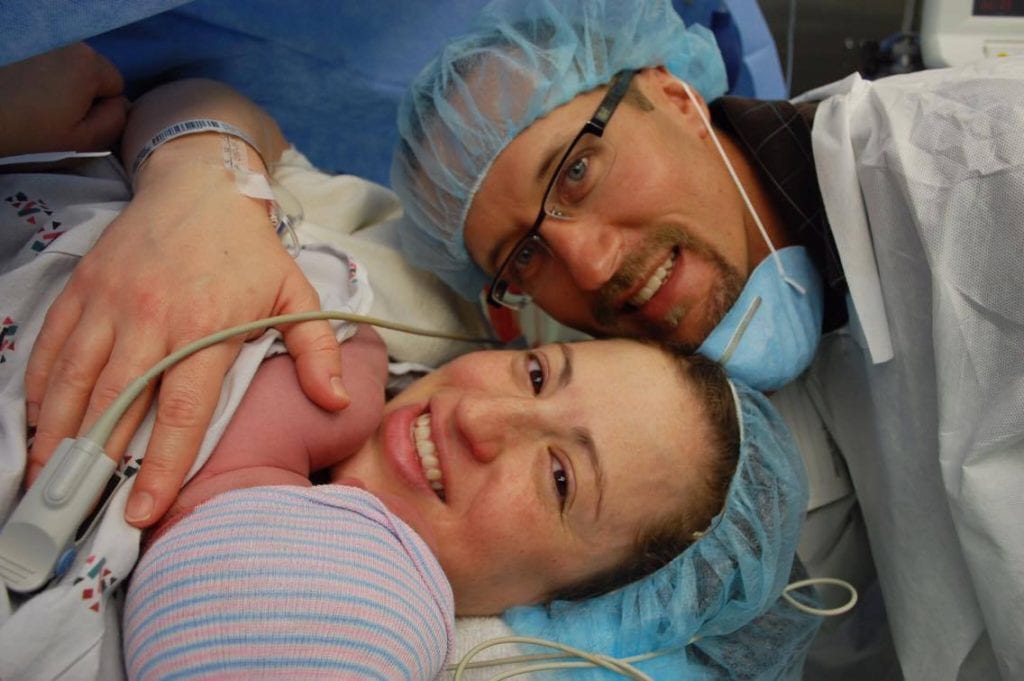
Unfortunately, there is an unpleasant smell during a cesarean birth – the smell of burning flesh or cauterized skin.
TIP: My favorite thing to combat this smell is to put 1-2 drops of lavender essential oil, or lemon essential oil if mom is feeling sick, on a cotton ball and leave it by her head. Remember, the area around mom’s head is not in the sterile field so it is ok to do something like this. Check out my article about essential oils for birth for more ideas.
The OR is a cold place, which helps reduce the risk of infection. The operating table is also cold and can definitely be uncomfortable. Many women find the experience of being flat on the back, while pregnant, also uncomfortable.
TIP: My clients have used breathing techniques such as breath awareness or non-focused awareness to help cope through this uncomfortable time.
Labor Land Fades
For those who have been in labor, but for whatever reason are now needing to have a cesarean birth, they may find that they are becoming more alert as their contractions space further and further apart. Throughout labor women are very focused and go within to cope. During a cesarean, however, some women find themselves coming out of that state, and are now more alert.
Just like in a vaginal birth, women giving birth by cesarean may feel shaky, cold, thirsty, nauseated and may even vomit (they will prophylactically give a medication to women, however, to try to make vomiting not happen).
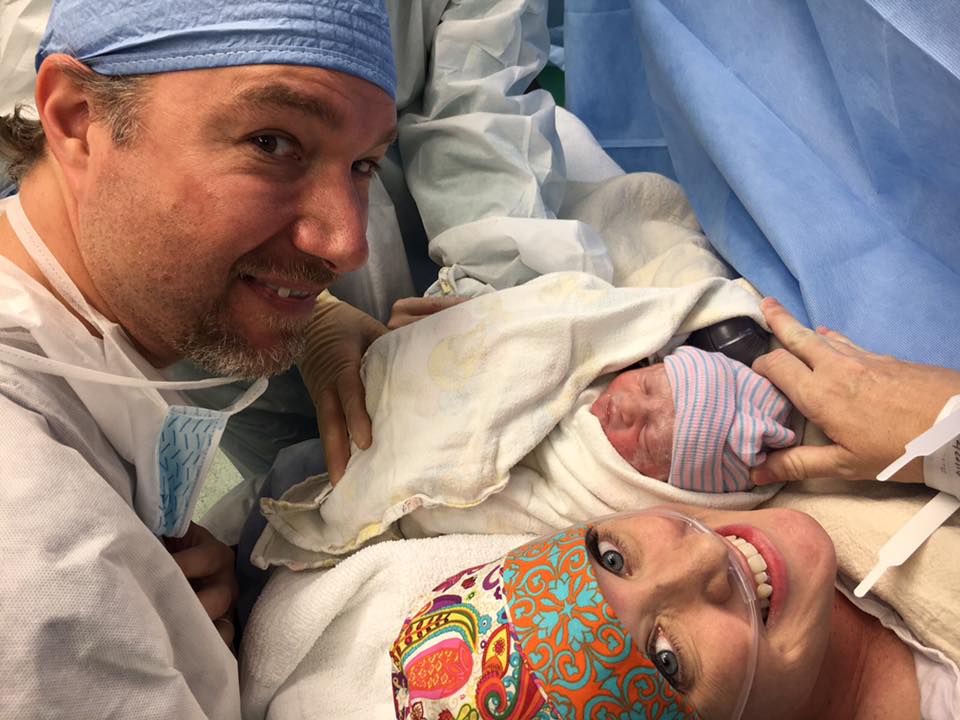
The Moment of Birth
Many women describe the moment of birth as a feeling of pressure, rocking and tugging. Some women don’t feel much at all. And some feel way more than that.
**If you are in pain at any time, please tell your anesthesiologist. Their number one job is to keep you comfortable and out of pain. You are not supposed to be feeling pain. Please speak up and let them know what you feel!
After the birth of the baby, typical protocol is to hold the baby up over the blue drape so that parents can see their new baby. If this is your experience, take a mental snapshot and hold this image in your mind until your baby is brought to you.
Again, typical protocol is to immediately clamp the cord and to take the baby to the warmer in the OR for a quick observation. Many cesarean birth babies have extra fluid in the lungs, so care providers are making sure that baby is transitioning to breathing room air accordingly.
Gentle C Section Immediate Postpartum
In recent years, there has been an exciting shift for a more gentle c section during the immediate postpartum protocol (while in the OR).
- The first thing that has changed is that (by request only) babies are being placed on their mothers’ chests immediately (in the OR directly following the birth) following birth. Finally, women having a cesarean can also experience the benefits of skin-to-skin. Did you know that skin-to-skin contact helps regulate a baby’s temperature, breathing, heart rate and both mom and baby can experience peak surges of oxytocin? The mom pictured below looks completely blissed out. How wonderful!
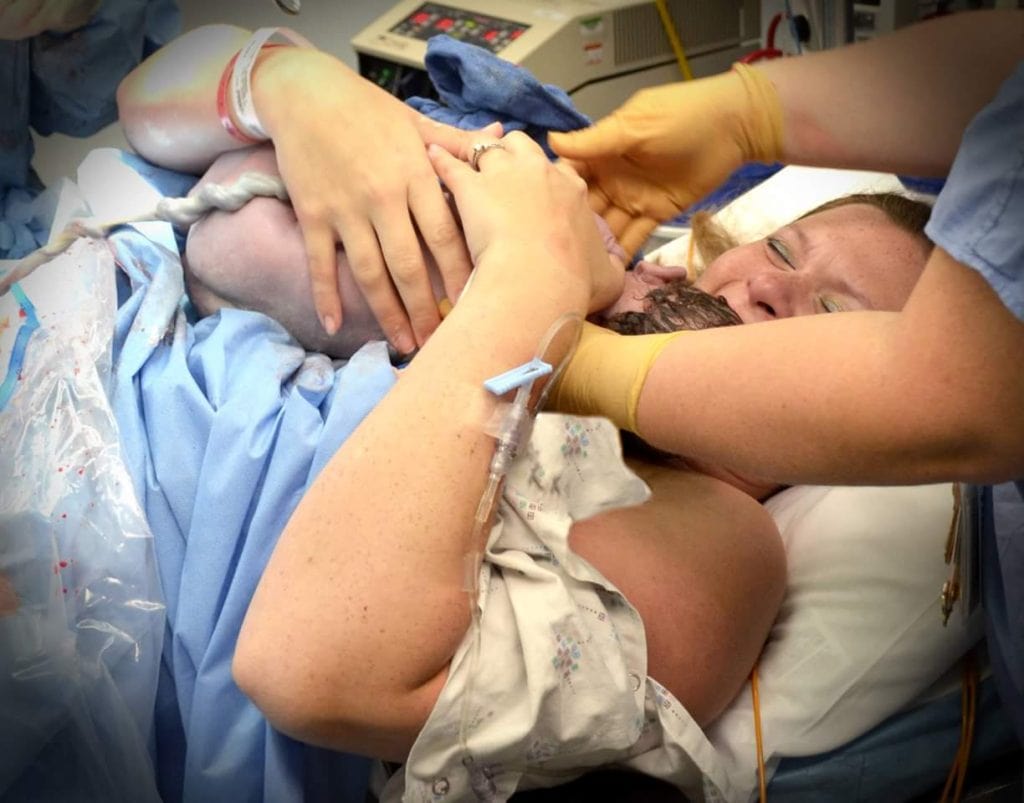
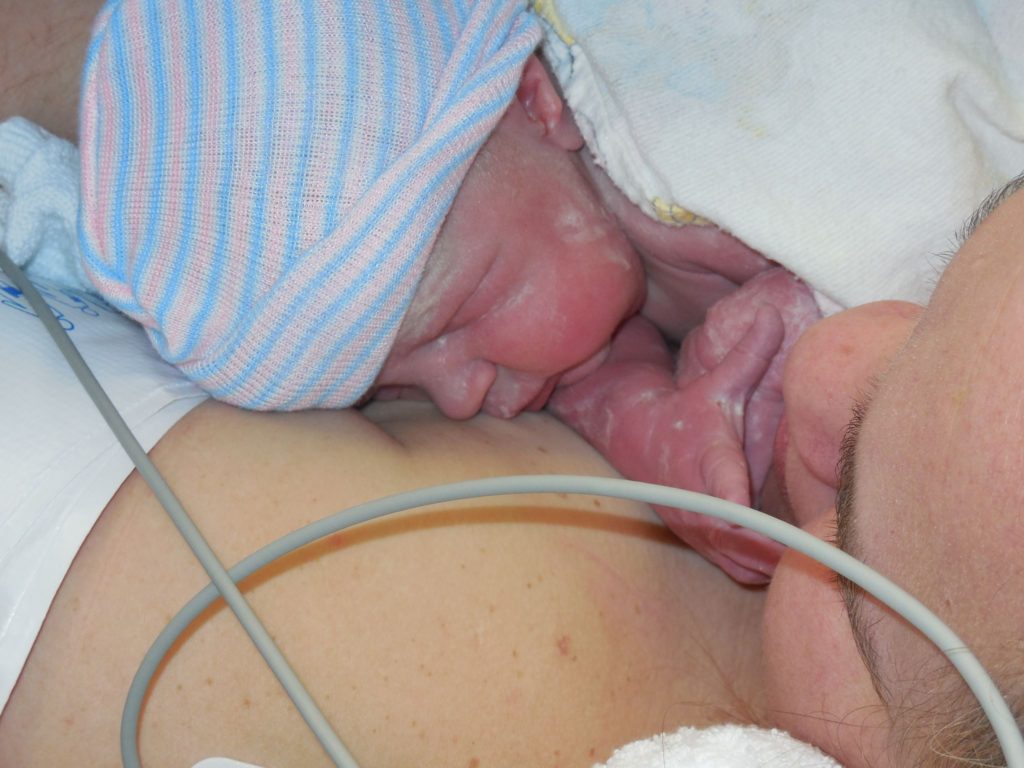
- The second thing that has changed is that (by request only) some babies are how experiencing delayed cord clamping. Have you heard of it? I’ve written an amazing article on delayed cord clamping that all should read, no matter what type of birth is planned. I’m not sure how long cutting the cord was delayed in the picture below, but I would guess at least 30 seconds. And 30 seconds is WAY better than 0 seconds.
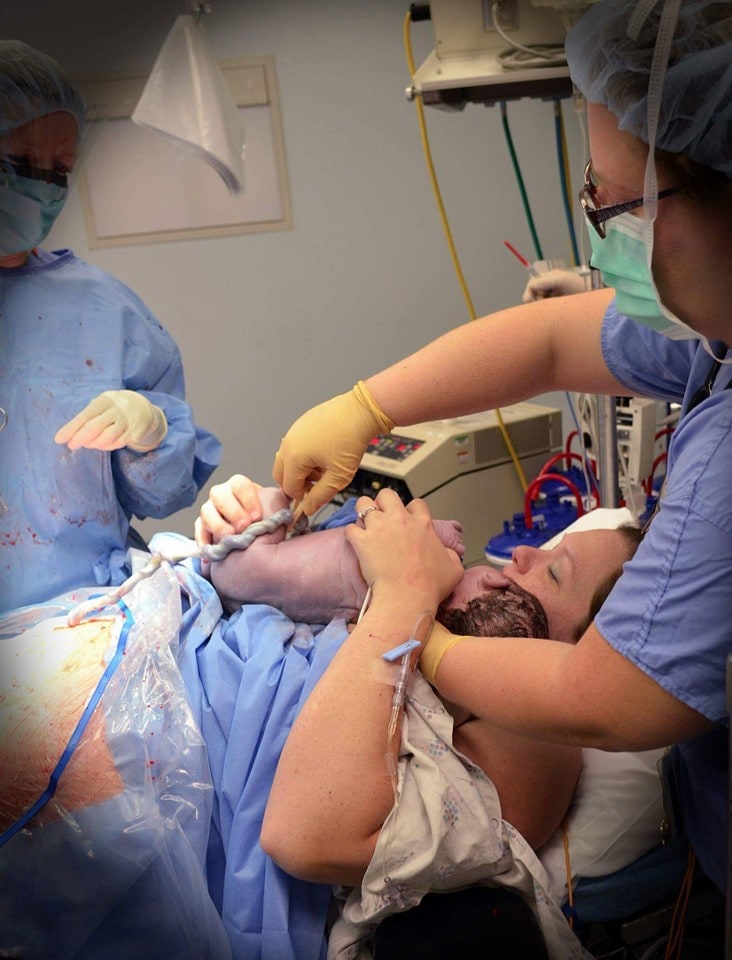
If immediate skin-to-skin contact and delayed cord clamping are important to you, talk with your care provider to discuss your options.
Medications
It’s at the anesthesiologist discretion as to what medications a mother receives during and after a cesarean. For example, if the anesthesiologist thinks that you are feeling anxious he or she may give you a medication for pain as well as anxiety.
Some of these medications, however, alter the mental clarity and perception of the new mother. Sometimes women are OK with this, as the operating room induces high levels of anxious thoughts and fears. Some women, despite being nervous, would rather only have medications that help with pain in order to stay lucid.
I know a handful of women that do not remember the first hours after the birth of their babies and they are not happy about it. If they could do it over again, they would insist upon medications only for pain and nothing else so that their mental clarity was not affected. If this is important to you, have a conversation with your care provider to discuss your options.
As far as I understand it, the typical medications given at a cesarean birth are safe for breastfeeding. There is no reason to delay breastfeeding, in fact the OR is a great time to try for the first time!
Recovery
After surgery, mom, dad and baby will be brought to a recovery room before heading to the postpartum floor or room. Ideally, the family unit would be brought together, but often dad and baby go first while mom’s surgery is finished. The mom below insisted on keeping baby with her so they were transported to the next location all together.
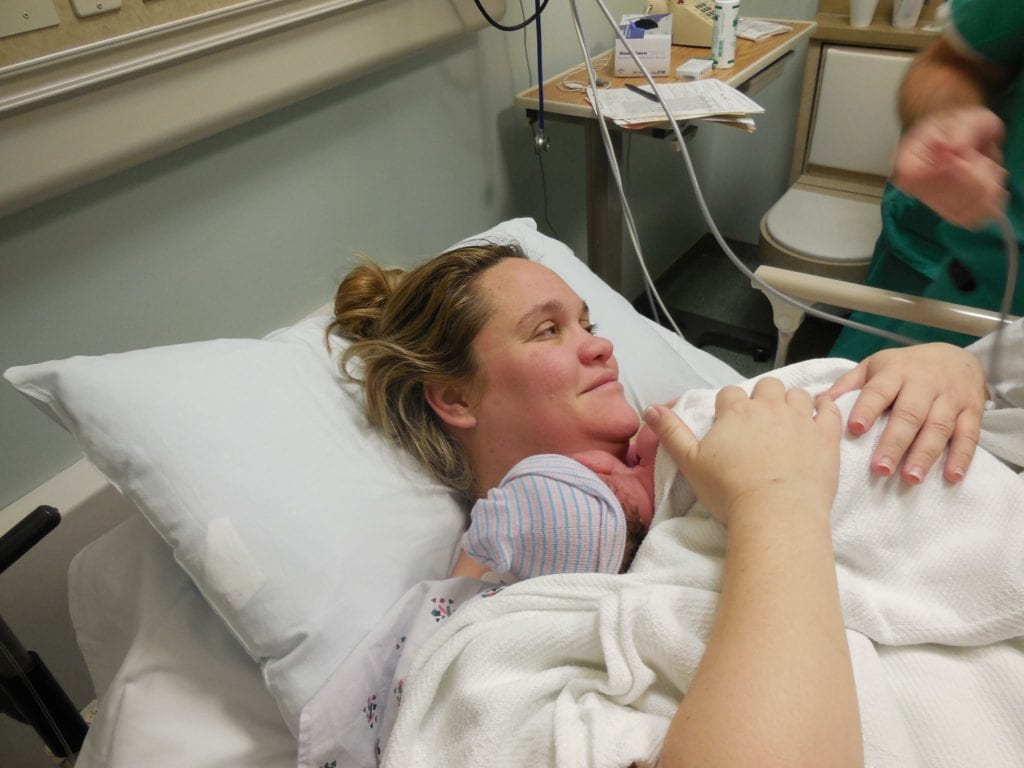
Breastfeeding
The recovery room is a great time to initiate breastfeeding if this already hasn’t happened. Because mom will be reclined on her back, she will need assistance getting baby into a good position. Ask a nurse, lactation counselor or doula for some assistance. They’ll be happy to help!
Walking Around
Sooner than you think possible, mom will be asked to take short walks – to the bathroom, and around the postpartum floor. This is good advice and helpful for healing and recovery! Careful, slow, steady walking will help recovery.
Postpartum Pads
Many parents have found the hospital mesh panties and giant maternity pad to be comfortable for postpartum recovery, especially compared to adult diapers. The mesh panties put less pressure on the incision site.
Paid Meds
Take all medications as directed by your care provider. Weaning off pain medications too soon will not help speed recovery.
TIP: If you are taking pain medication, you also need to take a stool softener. Magnesium may be the perfect, natural supplement to keep things moving. 😉
Heavy Lifting
Women will be instructed to not lift anything heavier than the baby – this means no driving, no picking up the carseat, no household chores, no picking up small children. Please follow the recovery guidelines received from a care provider.
TIP: Use a pillow or your hands to brace your incision when you cough or sneeze.
Help At Home
Women will need additional help at home, for a longer period of time. Mom’s two jobs are 1) feeding the baby and 2) to recover. That’s it. This may be a good time to hire a postpartum doula.
A cesarean recovery has some similarities to a vaginal recovery in that every recovery is different. I have known women to feel better before six weeks postpartum, but most women take longer. And some take MUCH LONGER! Again, this is the same with the recovery for vaginal deliveries.
Create A Gentle C Section Birth Plan
Even if you are not planning to give birth by cesarean, I challenge you to write out a small birth plan describing 3-5 things you would like to have happen if it did become your next best thing. If possible, do this with your birth partner(s).
Many pregnant women think that a cesarean “won’t ever happen to me” but somehow find themselves in the OR delivering their baby. Do your future self a favor, and figure out what would be important to you just in case you give birth by cesarean.
And I promise, thinking about a gentle c section, talking about it and planning for one just in case won’t make one more likely to happen.
Some things to consider adding to a gentle c section birth plan may be:
- No separation of dad, mom and baby
- Only use medications that don’t alter mom’s cognitive abilities
- Skin-to-skin in the OR
- Delayed cord clamping
- Essential oils in the OR
- Photos and/or video of the birth
- Music in the OR
- Doula in the OR
- Arms free to move
Make It Happen
To plan a gentle c section two things need to happen.
- The first is you need to (learn to) advocate for yourself.
- The second is you need a care provider that wants what you want and will help make a gentle c section happen.
For some great tips on how to talk with your care provider check out this post.

SaRah
Saturday 20th of January 2018
The hospital I delivered my elected c-section baby at does gentle cesearean birth. It was actually a great experience! My first first was vaginal and just terrible mainly due to a very long labor and botched episiotomy that I didn’t even want. I was nervous to do anything when I found out I was pregnant with my second, but obviously she had to come out somehow. I researched c-sections and talked to my doctor about it. He was supportive of whatever I wanted but did mention a c-section has a more predictable healing process. My vaginal delivery took 6 months to even start healing so that’s what I wanted. I felt the need to know exactly what I was getting into so I researched like crazy what to expect and how to heal well, and it was so much better than I thought it would be. I’m pregnant with my third now and going with another cs, though I know a bit more what to expect, which actually is making me anxious. However, knowing they let me hold the baby right away and they are pro-breastfeeding at my hospital makes it so much better. I love the idea of adding EOs to my OR experience though, and will definitely do that!
Brenna
Saturday 11th of November 2017
My c-section was an emergency c-section because the baby was in distress. I remember nothing but the he first few minutes in the operating room. We were able to have our doula with us and I was so thankful as our little one was sick and wished off to the n-icu. I'm thankful for my anesthesiaologist for letting my doula in. It gave me someone to talk about the process and help me heal. I'm also greatful looking back that I don't have my memory of those scary moments, but the protected stories of my husband and doula. It made it so I was less freaked out by the experience and able to focus on recovery and my beautiful baby.
Lindsey
Thursday 16th of November 2017
Thank you so much for sharing. ♥
Corinn fitzgerald
Sunday 7th of August 2016
In my birth my care provider had actually little to nothing to do with it being a gentle cesarean. You need to get the anesthesiologist and especially the nurses on board. My doctor did the procedure but it's the anesthesiologists domain on what happens and it really matters how many nurses are on staff and can help. You need several nurses to hold the baby during skin to skin (at first). But it was my or nurse that made skin to skin happen for me.